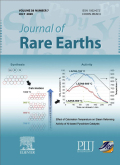- 钛学术文献服务平台 \
- 学术期刊 \
- 工业技术期刊 \
- 冶金工业期刊 \
- 稀土学报(英文版)期刊 \
Structure regulation for ultra-high luminescence quantum yield lanthanide complex and simultaneous detection of cancer marker and ferrous ion
Structure regulation for ultra-high luminescence quantum yield lanthanide complex and simultaneous detection of cancer marker and ferrous ion
基本信息来源于合作网站,原文需代理用户跳转至来源网站获取
摘要:
The exploitation of a highly selective and sensitive probe to detect both cancer marker and metal ion is of great importance.In this work,the "one stone two bird" agent of 1,10-phenanthroline (phen) is designed to disrupt the polymeric lanthanide MOFs (LnMOFs,[Ln(CHO2)3]n,Ln =Tb,1a;Eu,1b,CHO2 =formic acid) {[Ln(CHO2)4.(C2H8N)]n,Ln =Y,2a;Gd,2b;Dy,2c,C2H8N =dimethylamine}) into a soluble mononuclear species[Ln(phen)2(NO3)3,Ln =Tb,3a;Eu,3b]as well as to provide an antenna for efficient photons absorption,resulting in an ultra-high luminescence quantum yield (QY,90%) europium complex.The luminescence QY is among the highest record of monomeric (zero-dimensional) lanthanide com-plexes.Furthermore,mononuclear Tb3+ complex (3a) functions as a multiplex sensor towards both Fe2+and cancer marker of 5-hydroxyindole-3-acetic acid (5-HIAA).Importantly,the limit of detection (LOD)for sensing 5-HIAA is an ultra-sensitive value of 1 × 10-8 mol/L,which is even lower than that necessary for the early diagnosis of carcinoid tumors.More interestingly,sensing results in simulated urine reveals that 3a has potential application for early diagnosis in the clinic.

推荐文章
Adsorption characteristics of copper ion on nanoporous silica
Nanoporous silica
Copper ion
Adsorption
Incorporation of silica into the goethite structure: a microscopic and spectroscopic study
Quartz
Goethite
Twinned goethite
Microscopic characterization (FESEM and TEM)
FT-IR spectroscopy
An experimental study of interaction between pure water and alkaline feldspar at high temperatures a
Alkaline feldspar
Autoclave
High-temperature and high-pressure experiments
Thermodynamic properties of San Carlos olivine at high temperature and high pressure
San Carlos olivine
Thermodynamic property
Thermal expansion
Heat capacity
Temperature gradient
内容分析
关键词云
关键词热度
相关文献总数
(/次)
(/年)
引文网络
引文网络
二级参考文献 (153)
共引文献 (1)
参考文献 (51)
节点文献
引证文献 (0)
同被引文献 (0)
二级引证文献 (0)
1981(1)
- 参考文献(0)
- 二级参考文献(1)
1997(1)
- 参考文献(1)
- 二级参考文献(0)
2001(1)
- 参考文献(0)
- 二级参考文献(1)
2003(2)
- 参考文献(0)
- 二级参考文献(2)
2005(5)
- 参考文献(0)
- 二级参考文献(5)
2006(1)
- 参考文献(0)
- 二级参考文献(1)
2007(3)
- 参考文献(0)
- 二级参考文献(3)
2008(1)
- 参考文献(0)
- 二级参考文献(1)
2009(7)
- 参考文献(0)
- 二级参考文献(7)
2010(5)
- 参考文献(0)
- 二级参考文献(5)
2011(12)
- 参考文献(1)
- 二级参考文献(11)
2012(5)
- 参考文献(0)
- 二级参考文献(5)
2013(18)
- 参考文献(2)
- 二级参考文献(16)
2014(20)
- 参考文献(2)
- 二级参考文献(18)
2015(21)
- 参考文献(3)
- 二级参考文献(18)
2016(25)
- 参考文献(2)
- 二级参考文献(23)
2017(27)
- 参考文献(7)
- 二级参考文献(20)
2018(29)
- 参考文献(13)
- 二级参考文献(16)
2019(17)
- 参考文献(17)
- 二级参考文献(0)
2020(3)
- 参考文献(3)
- 二级参考文献(0)
2021(0)
- 参考文献(0)
- 二级参考文献(0)
- 引证文献(0)
- 二级引证文献(0)
引文网络交叉学科
相关学者/机构
期刊影响力
稀土学报(英文版)
主办单位:
中国稀土学会
出版周期:
月刊
ISSN:
1002-0721
CN:
11-2788/TF
开本:
大16开
出版地:
北京新街口外大街2号中国稀土学报编辑部
邮发代号:
2-613
创刊时间:
1990
语种:
eng
出版文献量(篇)
4423
总下载数(次)
0
总被引数(次)
17485
期刊文献
相关文献
推荐文献
- 期刊分类
- 期刊(年)
- 期刊(期)
- 期刊推荐
一般工业技术
交通运输
军事科技
冶金工业
动力工程
化学工业
原子能技术
大学学报
建筑科学
无线电电子学与电信技术
机械与仪表工业
水利工程
环境科学与安全科学
电工技术
石油与天然气工业
矿业工程
自动化技术与计算机技术
航空航天
轻工业与手工业
金属学与金属工艺
稀土学报(英文版)2022
稀土学报(英文版)2021
稀土学报(英文版)2020
稀土学报(英文版)2019
稀土学报(英文版)2018
稀土学报(英文版)2017
稀土学报(英文版)2016
稀土学报(英文版)2015
稀土学报(英文版)2014
稀土学报(英文版)2013
稀土学报(英文版)2012
稀土学报(英文版)2011
稀土学报(英文版)2010
稀土学报(英文版)2009
稀土学报(英文版)2008
稀土学报(英文版)2007
稀土学报(英文版)2006
稀土学报(英文版)2005
稀土学报(英文版)2004
稀土学报(英文版)2003
稀土学报(英文版)2002
稀土学报(英文版)2001
稀土学报(英文版)2000
稀土学报(英文版)2021年第9期
稀土学报(英文版)2021年第8期
稀土学报(英文版)2021年第7期
稀土学报(英文版)2021年第6期
稀土学报(英文版)2021年第5期
稀土学报(英文版)2021年第4期
稀土学报(英文版)2021年第3期
稀土学报(英文版)2021年第2期
稀土学报(英文版)2021年第10期
稀土学报(英文版)2021年第1期

 免费查重
免费查重










